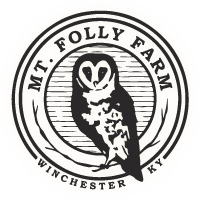At Mt. Folly, we practice regenerative agriculture. We rotationally graze our cattle, mimicking buffalo, and have been doing this for decades. Because of the beeves manure and sharp hooves, this practice builds organic matter in pasture soils. We also graze the cattle on the cover crops planted on crop ground.
According to Gabe Brown, Allan Savory, and our own data, animals are crucial for building soil carbon. Mimicking bison and other ungulates, cattle become part of the food web. Their herding instinct, coupled with their manure and group trampling tendency, improve the soil, allowing it to return to its original place in the ecologic system — a carbon sink.
Next, after the cash crop is harvested, we plant cover crops on all crop land, achieving the goal of having the soil covered year-round. In addition to their complex root system, with mycorrhizal fungi and other soil microbes feeding the soil biology, the cash crop plants followed by cover crop plants all photosynthesize, turning atmospheric carbon into food and nourishing the soil’s biology. This system returns oxygen to the atmosphere.
Thirdly, we reduce or eliminate tillage wherever we can. As organic farmers, this is the most challenging task for climate and stable soil carbon.
Finally, we plant trees on the farm’s steep hillsides, making up about a quarter of the farm’s acreage. Our mixed species timber stands are managed with input from a professional forester, so that trees are kept growing, sequestering carbon as they grow.

